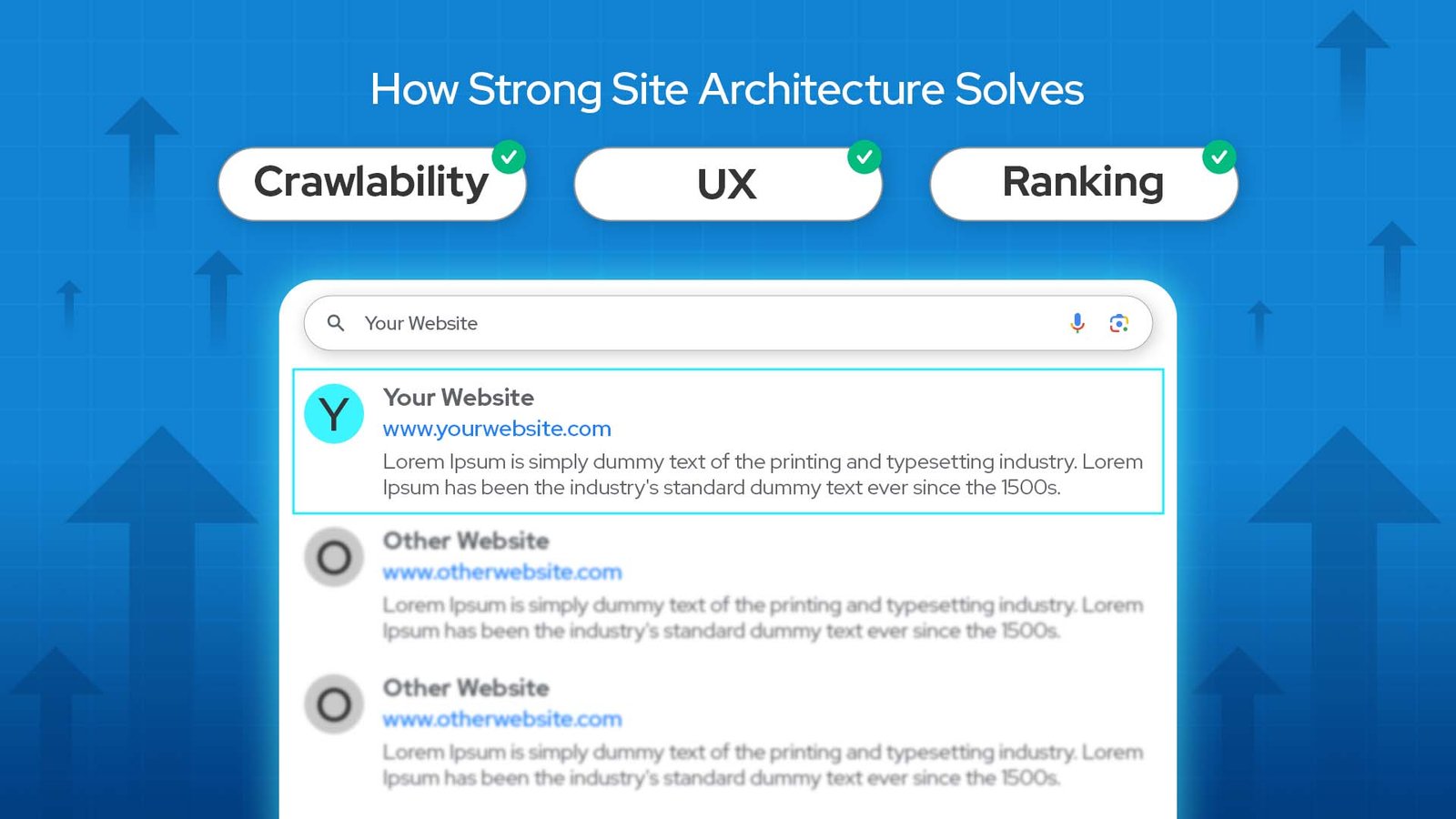- Admin
- August 22nd, 2025
- 7 min Read
How Strong Site Architecture Solves Crawlability, UX, and Ranking Problems
When your website fails to rank, it’s tempting to blame content or backlinks. But often, the real problem lies deeper—your site architecture. If search engines can’t crawl your pages efficiently, or if users get lost navigating your site, your SEO efforts will underperform.
The solution? A strategic site structure that eliminates crawl traps, improves user experience, and boosts rankings. Let’s break down common problems businesses face—and how different types of site architectures can solve them.
Problem 1: Search Engines Can’t Crawl Your Website Properly
- Issue: Orphan pages, confusing navigation, and too many clicks from the homepage make it hard for Googlebot to find and index content.
- Impact: Important pages remain invisible in search results, no matter how well they’re optimized.
Solution: Hierarchical Architecture (Tree Model)
-
Think of this as: A clear family tree for your website.
Homepage → Categories → Subcategories → Pages. - Example: Home → Blog → SEO → Technical SEO → Crawlability.
Why it works:
- Creates logical pathways for crawlers
- Groups related content together, building keyword relevance.
- Prevents pages from getting buried too deep (the 3-click rule).
- ???? Best for: eCommerce stores, blogs, and service websites with layered offerings.
Problem 2: Users Drop Off During Processes
- Issue: Complex sign-up flows, course lessons, or multi-step forms frustrate users.
- Impact: High bounce rates, low conversions, and poor engagement signals that hurt rankings.
Solution: Sequential Architecture (Linear Flow)
A step-by-step structure that guides users like a straight road.
- Example: Home → Step 1 → Step 2 → Step 3 → Completion.
Why it works:
- Reduces confusion, keeps users on track.
- Great for funnels, tutorials, or onboarding.
- Sends positive engagement signals to search engines.
Best for: SaaS platforms, e-learning portals, and conversion-driven landing pages.
Problem 3: Content Exists, But Authority is Weak
- Issue: You publish lots of content, but none of it ranks strongly. Google sees isolated pages instead of a connected knowledge hub.
- Impact: Missed opportunities to build topical authority.
Solution: Matrix Architecture (Interlinked Model)
Instead of strict hierarchy, this allows cross-linking between related content.
- Example: A blog on “Site Architecture” links to “Internal Linking”, which links to “Technical SEO”.
Why it works:
- Builds a web of contextual links.
- Distributes link equity across pages.
- Helps Google recognize content clusters and expertise.
Best for: Blogs, knowledge bases, or any content-rich site (like Wikipedia).
Problem 4: Dynamic Websites Trap Crawlers
- Issue: Marketplaces, travel sites, or SaaS platforms generate dynamic URLs that confuse crawlers (endless filters, session IDs, duplicate content).
- Impact: Crawl budget wasted, rankings diluted.
Solution: Database-Driven Architecture (Dynamic + Optimized)
Pages are generated on demand from a database, but with SEO best practices applied.
- Example: Real estate site where users search by location, price, or property type.
Why it works:
- Provides personalized, scalable pages.
- Requires technical fixes like canonical tags, clean URL parameters, and XML sitemaps.
- Balances flexibility with crawlability.
Best for: Marketplaces, SaaS platforms, eCommerce sites with thousands of products.
Best Practices That Solve Site Architecture Problems
Regardless of the structure you choose, apply these rules to keep SEO and UX strong:
- Use clean, descriptive URLs.
- Limit clicks to 3 or fewer from the homepage.
- Implement breadcrumbs for context.
- Build internal link hubs (pillar pages) to strengthen clusters.
- Avoid duplicate navigation paths.
- Ensure your XML sitemap matches your site’s actual structure.
Mistakes That Keep Businesses Stuck
Even with good intentions, many sites fail because they:
- Leave orphan pages unlinked.
- Use overcomplicated navigation menus.
- Forget to optimize for mobile-first users.
- Create too many dynamic URLs without canonicalization.
Frequently Asked Questions (FAQs)
1. What is the best site architecture for SEO?
The best architecture depends on your website type. For most businesses, a hierarchical structure works best because it organizes content in clear categories, making it easier for search engines to crawl and for users to navigate.
2. How does site architecture improve crawlability?
A strong architecture creates logical navigation paths and keeps important pages close to the homepage. This ensures that Googlebot can discover and index pages efficiently, preventing orphan pages and crawl waste.
3. Which site architecture is best for eCommerce websites?
Hierarchical architecture is usually best for eCommerce stores, as it organizes products under categories and subcategories. However, if the store has thousands of products, a database-driven structure with SEO-friendly URLs and sitemaps may be more effective.
4. What is the 3-click rule in site architecture?
The 3-click rule suggests that any page should be reachable within three clicks from the homepage. This makes it easier for users to find content and for crawlers to access deeper pages.
5. How does internal linking support SEO within site architecture?
Internal links distribute link equity across pages, help Google understand relationships between content, and guide users to relevant resources. In matrix-style architectures, internal linking is especially powerful for building topical authority.



